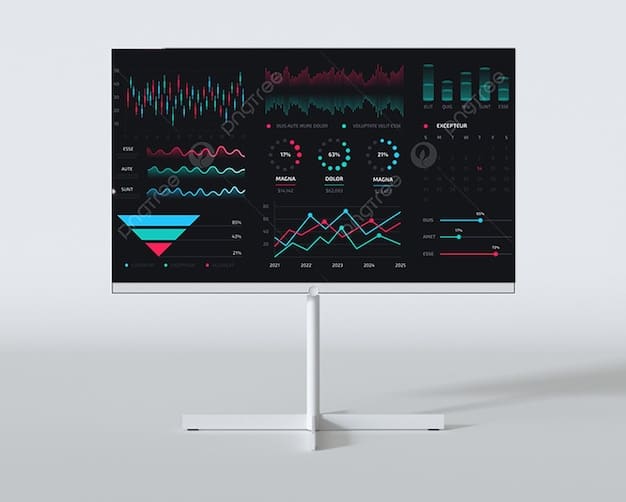Unlock the Power of Programmatic Advertising for US Marketers

Programmatic advertising offers US marketers a data-driven approach to efficiently target and engage with specific audiences across various digital channels, optimizing ad spend and maximizing ROI through automated buying and real-time bidding.
Ready to revolutionize your marketing strategy with data? Discover the power of programmatic advertising and how it can transform your campaigns for US audiences.
Understanding Programmatic Advertising: A Primer for US Marketers
Programmatic advertising is reshaping how US marketers approach their campaigns. It’s about leveraging data and automation to create more efficient and effective advertising strategies.
Instead of traditional methods of buying ad space, programmatic advertising uses algorithms to purchase ads in real-time, targeting specific demographics and behaviors.
The Core Components of Programmatic Advertising
Understanding the key elements of programmatic advertising is essential for US marketers looking to harness its potential:
- Real-Time Bidding (RTB): This is the auction-based system where ad impressions are bought and sold in real-time.
- Demand-Side Platforms (DSPs): These platforms allow advertisers to manage their ad campaigns, set targeting parameters, and bid on ad space.
- Supply-Side Platforms (SSPs): Publishers use SSPs to offer their ad inventory to potential buyers.
- Data Management Platforms (DMPs): DMPs collect and analyze data to provide insights into audience behavior and targeting.
These components work together to create a dynamic advertising ecosystem that empowers US marketers to deliver personalized ads to the right people at the right time.
By implementing programmatic advertising, US marketers can transform their advertising efforts into a highly efficient and targeted marketing process.
The Benefits of Programmatic Advertising for US Campaigns
Programmatic advertising offers numerous advantages for US marketers aiming to boost their campaign performance. Let’s explore some key benefits.
From improved targeting to enhanced efficiency, programmatic advertising can significantly optimize advertising ROI.

Enhanced Targeting Capabilities
One of the most significant benefits of programmatic advertising is its ability to target specific audiences with unparalleled precision. Here’s how:
- Demographic Targeting: Reach users based on age, gender, location, income, and more.
- Behavioral Targeting: Target users based on their online behavior, interests, and purchase history.
- Contextual Targeting: Display ads on websites and content that align with your target audience’s interests.
- Retargeting: Re-engage users who have previously interacted with your website or ads.
This level of targeting ensures that your ads are seen by the people most likely to be interested in your products or services, dramatically improving campaign effectiveness.
Programmatic advertising is more than an advertising method; it’s a pathway to connecting with your audience more meaningfully and with greater impact.
Data-Driven Decision Making in Programmatic Advertising
Data is the lifeblood of programmatic advertising, enabling US marketers to make informed decisions and optimize their campaigns in real-time.
By leveraging data analytics, marketers can gain insights into ad performance, audience behavior, and campaign effectiveness.
Leveraging Data Analytics for Campaign Optimization
Data analytics plays a critical role in optimizing programmatic advertising campaigns:
Analyzing campaign data allows you to understand which ads are performing well, which audiences are most receptive, and which channels are delivering the best results.
By continuously monitoring and analyzing data, US marketers can fine-tune their campaigns to achieve optimal performance, ensuring that every dollar spent contributes to tangible results.

Ad Fraud Prevention in Programmatic Advertising
Ad fraud is a significant concern for US marketers investing in programmatic advertising. Implementing robust fraud prevention measures is crucial for protecting ad spend and ensuring campaign integrity.
- Employing Fraud Detection Tools: Use specialized software to identify and block fraudulent traffic and impressions.
- Working with Certified Partners: Collaborate with ad networks and platforms that have strong fraud prevention policies.
- Monitoring Campaign Performance: Regularly analyze campaign data to detect suspicious activities and anomalies.
By taking proactive steps to prevent ad fraud, US marketers can safeguard their investments and ensure that their ads are seen by real people, maximizing campaign ROI.
Ad fraud prevention is not optional; it’s an absolute necessity for responsible and effective programmatic advertising. Prioritizing these measures will protect your investments and ensure your campaigns achieve their objectives.
Navigating the Programmatic Advertising Landscape in the US
The programmatic advertising landscape in the US is complex, with numerous platforms, technologies, and vendors to choose from. Here’s guidance for navigating it effectively.
Selecting the right partners and platforms is essential for achieving your advertising goals. Consider factors such as targeting capabilities, data access, pricing models, and customer support.
Before diving into programmatic advertising, US marketers need to clearly define their goals and objectives. What are you trying to achieve with your campaigns?
Key Considerations for US Marketers
Here are key factors to consider when selecting programmatic advertising platforms and partners:
Understanding these elements will enable US marketers to make informed decisions and build successful programmatic advertising strategies, driving measurable results and achieving their marketing objectives.
The Future of Programmatic Advertising: Trends and Predictions
The field of programmatic advertising continues to evolve at a rapid pace, driven by technological advancements and changing consumer behaviors. Tracking these trends is vital for US marketers.
- AI-Powered Optimization: AI and machine learning will play an increasingly important role in optimizing ad campaigns, enhancing targeting, and improving ROI.
- Cross-Channel Programmatic: Programmatic advertising will expand beyond traditional digital channels to include connected TV, audio, and out-of-home advertising.
- Privacy-First Approach: With growing concerns about data privacy, programmatic advertising will need to adopt more privacy-friendly targeting and measurement methods.
By embracing these trends, US marketers can stay ahead of the curve and leverage programmatic advertising to achieve greater success in the years ahead.
Innovation in programmatic advertising is the linchpin to staying ahead in a competitive advertisement environment. By embracing innovation and change, US marketers can achieve higher level marketing results.
| Key Point | Brief Description |
|---|---|
| 🎯 Precision Targeting | Reach specific demographics and behaviors with unmatched precision. |
| 📊 Data-Driven Decisions | Optimize campaigns in real-time using data analytics for higher ROI. |
| 🛡️ Ad Fraud Prevention | Protect ad spend by implementing robust fraud prevention measures. |
| 🤖 AI Optimization | Utilize AI and machine learning to enhance targeting and improve ROI. |
Frequently Asked Questions
▼
Programmatic advertising uses automation to buy and sell ad space efficiently, targeting specific audiences with personalized ads in real-time, optimizing ad spend and ROI.
▼
RTB is an auction-based process where ad impressions are bought and sold instantly. Advertisers bid on impressions, and the highest bidder’s ad is displayed to the user.
▼
Data drives programmatic advertising by providing insights into audience demographics, behaviors, and preferences. This enables targeted campaigns and optimized ad delivery.
▼
Key challenges include ad fraud, ensuring data privacy, navigating the complex landscape of platforms, and staying updated with ongoing technological advancements.
▼
US marketers should start by defining clear campaign goals, selecting the right platforms, establishing data privacy protocols, and understanding data analytic implementations for programmatic results.
Conclusion
As US marketers navigate the ever-evolving digital landscape, understanding and leveraging the power of programmatic advertising becomes essential for success. By embracing data-driven strategies, implementing robust fraud prevention measures, and staying abreast of industry trends, marketers can unlock its full potential and achieve measurable ROI.





